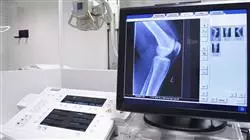University certificate
The world's largest faculty of medicine”
Introduction to the Program
New techniques and protocols of action in the diagnosis and therapeutic processes of patients, make it essential to always be aware of the most up-to-date information on radiology”

Radiology has been increasing in importance in the healthcare system. The support of medical radiology has become essential in the routine medical pratise in other specialisms. Technology today facilitates the performance of imaging tests that not long ago required surgical interventions, and the associated risks, in order to gain access to the evidence that allows you to make the appropriate diagnostic judgment in each case.
An early and precise diagnosis increases survival rates and lowers the morbidity of The patients. Therefore, a radiologist is a fundamental part of providing quality medical care, integrating the technological advances in radio-diagnosis into the medical practice of the rest of the specialisms.
Similarly, percutaneous treatments have also evolved rapidly in recent years, due to the constant development of new materials and equipment. For this reason, the specialist must undergo continuous learning in order to be kept up to date and to offer the best care in diagnostic and therapeutic procedures that medicine allows at any given time.
Bring your knowledge up to date with the Professional master’s degree in Update on Diagnostic and Therapeutic Techniques in Radiology”
This Professional master’s degree in Update on Diagnostic and Therapeutic Techniques in Radiology contains the most complete and up-to-date scientific program on the market. The most important features include:
- More than 150 clinical cases, recorded with POV (Point Of View) systems from different angles, presented by experts in surgery and other specialisms
- The graphic, schematic, and practical contents with which they are created, provide scientific and practical information on the disciplines that are essential for professional practice
- Presentation of practical workshops on procedures and techniques.
- An algorithm-based interactive learning system for decision-making in the clinical situations presented throughout the course.
- Action protocols and clinical practice guidelines which cover the most important latest developments in this specialist area
- All of this will be complemented by theoretical lessons, questions to the expert, debate forums on controversial topics, and individual reflection assignments.
- Special emphasis on test-based medicine and research methodologies in radiology
- Content that is accessible from any fixed or portable device with an Internet connection
This Professional master’s degree is the best investment you can make when selecting a refresher program, for two reasons: in addition to updating your knowledge in Update on Diagnostic and Therapeutic Techniques in Radiology, you will obtain a qualification from TECH”
The teaching staff includes a team of healthcare professionals, who bring their experience to this training program, as well as renowned specialists from leading scientific societies.
The multimedia content, developed with the latest educational technology, will provide the professional with situated and contextual learning, i.e., a simulated environment that will provide an immersive program designed to learn in real situations.
This program is designed around Problem-Based Learning, whereby the radiologist must try to solve the different professional practice situations that arise throughout the program. For this reason, you will be assisted by an innovative, interactive video system created by renowned and experienced experts in the field of Radiology with extensive teaching experience.
Improve your daily medical practice with this specialized program"

Increase your decision-making confidence by updating your knowledge through this Professional master’s degree"
Why study at TECH?
TECH is the world’s largest online university. With an impressive catalog of more than 14,000 university programs available in 11 languages, it is positioned as a leader in employability, with a 99% job placement rate. In addition, it relies on an enormous faculty of more than 6,000 professors of the highest international renown.

Study at the world's largest online university and guarantee your professional success. The future starts at TECH”
The world’s best online university according to FORBES
The prestigious Forbes magazine, specialized in business and finance, has highlighted TECH as “the world's best online university” This is what they have recently stated in an article in their digital edition in which they echo the success story of this institution, “thanks to the academic offer it provides, the selection of its teaching staff, and an innovative learning method aimed at educating the professionals of the future”
A revolutionary study method, a cutting-edge faculty and a practical focus: the key to TECH's success.
The most complete study plans on the university scene
TECH offers the most complete study plans on the university scene, with syllabuses that cover fundamental concepts and, at the same time, the main scientific advances in their specific scientific areas. In addition, these programs are continuously being updated to guarantee students the academic vanguard and the most in-demand professional skills. In this way, the university's qualifications provide its graduates with a significant advantage to propel their careers to success.
TECH offers the most comprehensive and intensive study plans on the current university scene.
A world-class teaching staff
TECH's teaching staff is made up of more than 6,000 professors with the highest international recognition. Professors, researchers and top executives of multinational companies, including Isaiah Covington, performance coach of the Boston Celtics; Magda Romanska, principal investigator at Harvard MetaLAB; Ignacio Wistumba, chairman of the department of translational molecular pathology at MD Anderson Cancer Center; and D.W. Pine, creative director of TIME magazine, among others.
Internationally renowned experts, specialized in different branches of Health, Technology, Communication and Business, form part of the TECH faculty.
A unique learning method
TECH is the first university to use Relearning in all its programs. It is the best online learning methodology, accredited with international teaching quality certifications, provided by prestigious educational agencies. In addition, this disruptive educational model is complemented with the “Case Method”, thereby setting up a unique online teaching strategy. Innovative teaching resources are also implemented, including detailed videos, infographics and interactive summaries.
TECH combines Relearning and the Case Method in all its university programs to guarantee excellent theoretical and practical learning, studying whenever and wherever you want.
The world's largest online university
TECH is the world’s largest online university. We are the largest educational institution, with the best and widest online educational catalog, one hundred percent online and covering the vast majority of areas of knowledge. We offer a large selection of our own degrees and accredited online undergraduate and postgraduate degrees. In total, more than 14,000 university degrees, in eleven different languages, make us the largest educational largest in the world.
TECH has the world's most extensive catalog of academic and official programs, available in more than 11 languages.
Google Premier Partner
The American technology giant has awarded TECH the Google Google Premier Partner badge. This award, which is only available to 3% of the world's companies, highlights the efficient, flexible and tailored experience that this university provides to students. The recognition as a Google Premier Partner not only accredits the maximum rigor, performance and investment in TECH's digital infrastructures, but also places this university as one of the world's leading technology companies.
Google has positioned TECH in the top 3% of the world's most important technology companies by awarding it its Google Premier Partner badge.
The official online university of the NBA
TECH is the official online university of the NBA. Thanks to our agreement with the biggest league in basketball, we offer our students exclusive university programs, as well as a wide variety of educational resources focused on the business of the league and other areas of the sports industry. Each program is made up of a uniquely designed syllabus and features exceptional guest hosts: professionals with a distinguished sports background who will offer their expertise on the most relevant topics.
TECH has been selected by the NBA, the world's top basketball league, as its official online university.
The top-rated university by its students
Students have positioned TECH as the world's top-rated university on the main review websites, with a highest rating of 4.9 out of 5, obtained from more than 1,000 reviews. These results consolidate TECH as the benchmark university institution at an international level, reflecting the excellence and positive impact of its educational model.” reflecting the excellence and positive impact of its educational model.”
TECH is the world’s top-rated university by its students.
Leaders in employability
TECH has managed to become the leading university in employability. 99% of its students obtain jobs in the academic field they have studied, within one year of completing any of the university's programs. A similar number achieve immediate career enhancement. All this thanks to a study methodology that bases its effectiveness on the acquisition of practical skills, which are absolutely necessary for professional development.
99% of TECH graduates find a job within a year of completing their studies.
Professional Master's Degree in Update on Diagnostic and Therapeutic Techniques in Radiology
Due to the nature of its practices and its direct relationship with technological advances, the area of radiology stands out as one of the most evolving branches of medicine in recent times, both in diagnostic aspects and in terms of modern percutaneous treatment techniques. Understanding the need for academic updating that accompanies the continuous process of development of the sector, at TECH Global University we have prepared our Professional Master's program in Updating Diagnostic and Therapeutic Techniques in Radiology, focused on the approach of the technical, technological, methodological and protocol novelties that determine the future development of radiological practices. Likewise, this postgraduate course will update the professional's knowledge in relevant aspects such as: knowledge of the latest advances in breast imaging techniques; methodological management of carotid, vertebral and cerebral stent placement processes, and other therapeutic neurointerventional techniques; and understanding of the new horizons of interventional radiology, including the use of new biomaterials and biomarkers of medical imaging.
Study a master's degree in radiology online
The approach to the technical particularities surrounding the correct development of the different radiological practices requires a high degree of preparation and expertise on the part of the specialized professional. In our Master's program you will acquire the tools, skills and knowledge necessary for the proper development of medical work regarding the application of techniques corresponding to the field of radiology. In this way, the theoretical and practical updating of concepts such as: the protocol aspects to be taken into account when performing a cavography procedure; and the proper methodological management of the processes of renal, prostatic, uterine and portal embolization.







